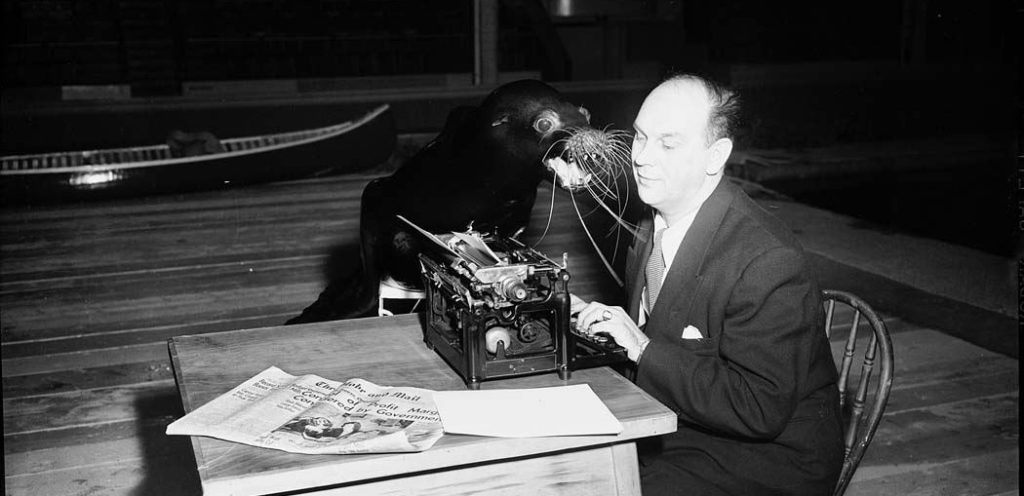
On Tuesday, The Globe and Mail marks its 175th birthday. As the newspaper would be glad to tell you, its story is intertwined with that of Canada, reflecting the changes in the country as it developed from British colony to modern nation — a steady presence in an ever-evolving mediascape. Since its beginning as The Globe in 1844, the paper has printed much it can be proud of, from founder George Brown’s promotion of abolitionism to its contemporary investigative reporting.
But, as with any institution that has been around so long, there are pieces of its past that the paper may be less eager to commemorate.
These are among the rougher, and sometimes darker, moments from its history, from the owner who turned the paper into an instrument for his quasi-fascist political movement, to a wide and changing variety of responses to plagiarism allegations.
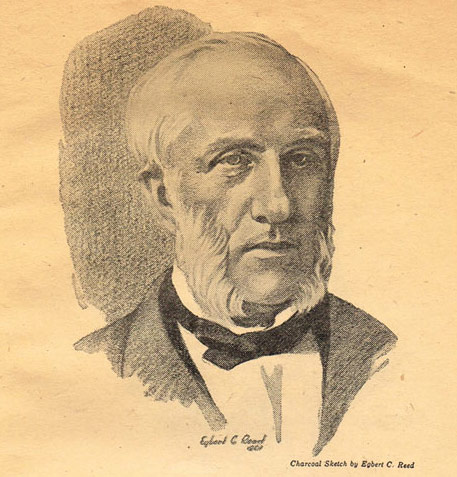
While George Brown praised international labour efforts to organize and secure better working conditions and a shorter workday, he was less enthusiastic when his own employees sought similar benefits. He believed that unions should not interfere with a non-union worker’s right to bargain their own contract, nor allow strikes to restrict the operation of business. As historian J.M.S. Careless observed in his book Brown of the Globe, “Brown might acknowledge a union’s right to exist — but very little more.”
This became clear in early 1872, when Toronto’s unionized printers supported the Nine-Hour Movement, a growing international effort to reduce the working day to a standardized nine hours. While some demands presented to the city’s newspapers, such as higher rates for night compositors, were accepted, most were rejected, and a strike date was set for March 25, 1872. When two reps from the Toronto Typographical Union (TTU) presented their demands to Brown, he exploded — partly because he didn’t appreciate anyone dictating how he should run his newspaper, and partly because the office foreman who usually handled such matters on his behalf was gravely ill. He fired the reps, and threatened to dismiss anyone who considered striking.
In a March 22 editorial, Brown declared that the papers had “submitted long enough to the insolent dictation of a few reckless lads…but they do so no longer.” Brown and his competitors formed the Master Printers Association, which advertised for non-union workers. Behind the scenes, Brown reputedly told the other newspaper owners to ostracize union members and destroy the movement.
The printers walked out on schedule.
Subsequent events only made Brown angrier. Attempts to hire scabs from across the province were foiled by members of the TTU who, with the aid of sympathetic train conductors, intercepted arrivals and booked them on the next train home. One of Brown’s competitors, the Leader, supported the strikers, though not for entirely altruistic reasons (the paper had declined as the city’s main Conservative voice, and owner James Beaty needed labour support to retain his seat in the upcoming federal election).
On April 15, over 10,000 strikers and Nine-Hour Movement supporters attended a rally at Queen’s Park. Brown immediately launched legal action against the strike leaders. Three days later, a magistrate ruled that, thanks to labour laws which hadn’t been updated in decades, unionization was illegal. The strikers gained public sympathy, and Brown was viewed as a tyrant, with The Ontario Workman reflecting shortly after that Brown had “maliciously and willfully endeavoured to injure [the arrested printers] in the eyes of their fellow citizens.”
The city’s newest Conservative paper, the Mail, opened itself up to the union. Brown’s longtime rival, Prime Minister Sir John A. Macdonald, retaliated by passing the Trade Union Act, protecting the right to unionize.
The strike eventually petered out, with both sides reaching compromises which, by June 1872, The Globe praised as “wise moderation” by all.
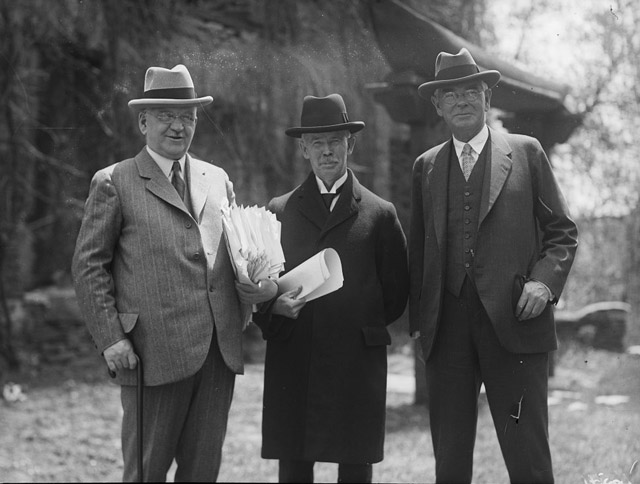
In the era of “Toronto the Good,” there were many prominent prudes in the city. But few were as extreme as William Gladstone Jaffray, who inherited The Globe from his father in 1914.
Over his two decades of ownership, he refused to run ads for alcohol and tobacco. He also banned ads for girdles, sanitary napkins, and women’s underwear. Only negative reviews were allowed for racy movies and atheist authors. Jaffray loved puff pieces about visiting evangelists, and showed more financial benevolence to his church than his employees.
One of Jaffray’s biggest pet peeves was gambling, especially horse racing. Beyond banning racetrack results from The Globe, he pressured Prime Minister William Lyon Mackenzie King to prohibit any Canadian publication from printing them. To appease Jaffray and maintain The Globe’s support for the Liberals, King introduced a bill to ban horse-racing results. It died in the Senate, prompting Jaffray to publish unflattering editorials about the prime minister and his party.
As a federal election loomed in 1925, King tried and failed again.
Jaffray interfered with managing editor John Lewis’s pro-Liberal editorials, causing Lewis and two other editors who were party loyalists to resign. (Lewis was soon rewarded by King with a job writing election propaganda, as well as a Senate seat). When King met with Jaffray to find middle ground, Jaffray questioned King’s Christian values. He killed several articles defending Liberal economic policy, provoking more editorial resignations. The Liberals paid out to at least two former editors their remaining salaries for the year.
A September 1, 1925, Globe editorial declared the paper offered “no allegiance to a party which can be permitted to stand in the way of its duty to its readers and the country.” When Canadians went the polls yet again in 1926, The Globe refused to endorse any party.
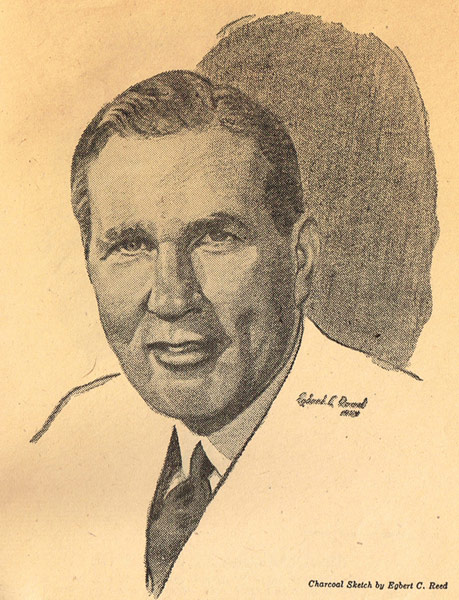
Legend has it that when George McCullagh, then a 23-year-old assistant finance editor with The Globe, left the paper in 1928, he told Jaffray, “When I next walk into this office, I’ll be buying the paper out from under you.”
His prediction came true: having made himself a millionaire on Bay Street, McCullagh, with the backing of mining magnate William H. Wright, bought The Globe in October 1936 and quickly reversed Jaffray’s policies. A month later, he bought Toronto’s other morning newspaper, the Conservative-leaning Mail and Empire, leading to the debut of The Globe and Mail on November 23.
McCullagh imagined himself as the ultimate political puppetmaster, using The Globe and Mail as a vehicle to influence government matters and public opinion to increase the power of business executives, especially from the mining industry. While the Globe had first called itself “Canada’s National Newspaper” in the early 20th century, by 1938 it was shipping copies across the country via air, which potentially allowed it to extend its influence.
Increasingly disillusioned by all political parties, McCullagh prepared a series of radio broadcasts titled “Let’s Do Some Plain Speaking,” which were rejected by the CBC. So McCullagh bought time on private stations for six broadcasts beginning in January 1939, offering simplistic attacks on high taxes and political corruption. His solution to Canada’s problems was to eliminate provincial governments and to turn over federal power to a single party run by the business elite. With no pesky opposition to question their motivations, these “sound, honest” businessmen, supported by the unconditional loyalty of average patriotic Canadians, would run the country smoothly.
“We do not need great brilliancy in the administration of public affairs,” McCullagh argued on one of the broadcasts. “We require rugged honesty, clear purpose, tireless energy, and unswerving loyalty to principles which we, as citizens of average intelligence, can appraise fairly.”
Across the country, opponents in the press felt that McCullagh’s vision — of a government based on “simple virtue” — bordered on fascism. An editorial in the February 3 edition of the Toronto Star said of his idea of to abolish provinces, “It is mischievous nonsense, a proposal calculated to create further disunity in Canada, a Fascist proposal because it is admittedly bound up with a scheme for making the proposed all-controlling central parliament a one-party parliament. And such parliaments, with such powers, have been, in other countries, the first fruits of dictatorships.”
But letters of support poured into The Globe and Mail’s office. Which gave McCullagh an idea.
During the final broadcast on February 12, he announced the birth of the “Leadership League.” Across eight pages of the next day’s edition of The Globe and Mail, McCullagh envisioned a populist political pressure group “through which a persevering people, by co-operative effort, may guard the country against further incompetency in the conduct of public affairs.”
The paper printed a membership form, which stated, “I wish to join The Leadership League for the purpose of RESTORING DEMOCRACY, REDUCING TAXATION, and PUTTING CANADIANS BACK TO WORK.” Another form, to be sent to MPs, declared, “I am a voter in your constituency. I earnestly ask you to FORGET PARTY ADVANTAGE and CO-OPERATE FOR THE COMMON GOOD.”
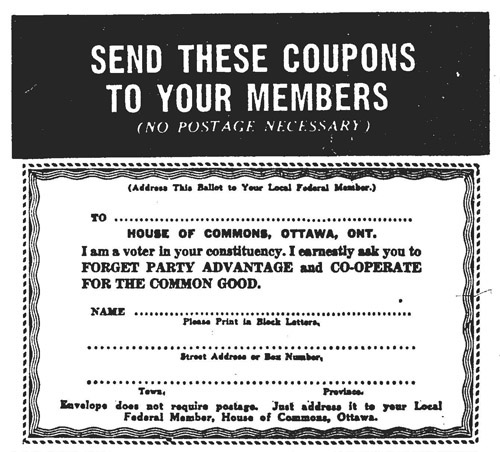
On Valentine’s Day, the daily Leadership League page debuted. It consisted of cartoons, criticism of tax policy, promotion of upcoming local meetings, and a blank space titled “What Parliament Has Done.” League propaganda filtered into other sections, especially “The Homemaker” page.
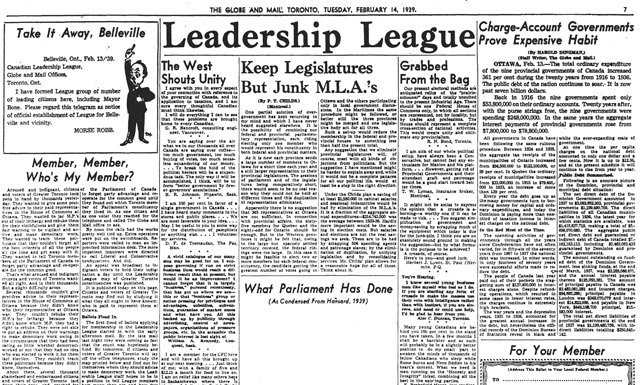
Writers were embarrassed to crank out glowing articles. “It was the sorriest job I ever had in my life,” reporter Royd Beamish recalled in Bassett, Maggie Siggins’s biography of League pitchman (and future media mogul) John Bassett. “What I did was slant the news. When a story came over the teletype that had some slight anti-Liberal bias, I rewrote it to make that bias stronger. When Bassett or one of the others spoke, it was mandatory that the top writer cover it, and God help him if he didn’t gush.”
By the end of the first week, the paper claimed 100,000 people had joined the League. Over 42,000 coupons were sent to the parliamentary post office in Ottawa. The organization took off in Toronto and small-town Ontario, but failed elsewhere — McCullagh had little use for French Canadians, while the West thought the organization was little more than a front for meddling Eastern elites.
Enthusiasm faded fast. A March 15 Maple Leaf Gardens rally drew only half of the expected 20,000 attendees. Funding from the business community failed to materialize, causing McCullagh to lose over $100,000. Nervous exhaustion forced him to take time off, and he attempted to shift leadership onto former Ontario lieutenant-governor Herbert Bruce and medical pioneer Frederick Banting. McCullagh ignored calls to turn the League into a political party, and never developed a detailed plan of action. Pages promoting the league remained in the paper until the plug was pulled that July.

Shortly after acquiring the Telegram in 1948, McCullagh told his new employees that he bought the paper to destroy his remaining competition in Toronto, the Star. “I’m going to knock that fucking rag right off its pedestal,” he promised at a meeting with the staff.
At the time, the Star had the largest circulation in the country with 365,000 copies, well ahead of The Globe and Mail (220,000) and Telegram (192,000).
When longtime Star publisher Joseph Atkinson died in May 1948, the paper was left to the Atkinson Charitable Foundation. Nearly a year later, on March 25, 1949, provincial treasurer Leslie Frost introduced the Charitable Gifts Act, which would allow charitable foundations to own no more than 10 percent of a business. The act, which would apply retroactively, would force these businesses to either split their ownership among other charities or force a sale within three years.
While Frost argued the legislation would promote honest business dealings and prevent tax evasion, nearly everyone else saw it as an attempt to harm the Star. Opposition MPPs saw McCullagh’s fingerprints all over it. Newspapers across the political spectrum, other than McCullagh’s, criticized the act, blaming both McCullagh and federal Progressive Conservative leader/Star enemy George Drew for influencing it.
“If the Star is forced to sell,” the Ottawa Citizen feared, “it may, of course, be picked up by the moneyed interests in sympathy with the Tories.”
While not admitting any role in crafting the legislation, McCullagh fully supported it. “Personally, I relish the blame,” he told Time magazine. “Knocking out that rag is my only passion.”
The outcry prompted Frost to introduce amendments which stretched the sale period from three years to seven and allowed trustees the right to buy. The bill passed. According to Roger Graham’s biography of Frost, Old Man Ontario, the future premier later admitted McCullagh had been more hindrance than help.
If McCullagh had tried to pull strings to destroy the Star, he failed. In 1958, the paper was sold to several of its trustees, creating the basis for the its current ownership arrangement. McCullagh did not live to see this; suffering from depression and various illnesses, he was found dead in his swimming pool in 1952.
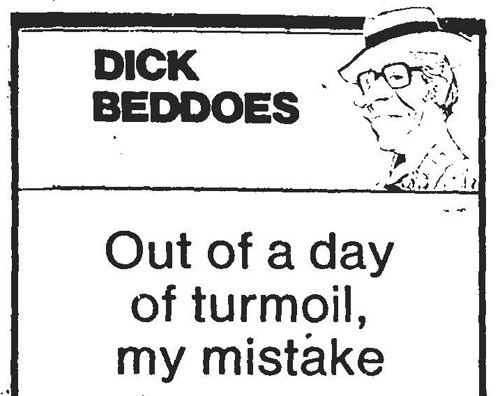
On September 3, 1980, civic affairs columnist Dick Beddoes wrote about the Toronto Board of Education’s outreach effort to the city’s gay community. He discussed the ways in which children did and did not emulate teachers, and the ridiculous fear among some people that homosexual teachers would convert children. He recalled teachers of his youth, reflecting on whether their sex lives had affected his.
One problem: Beddoes’ humorous reflections resembled a column Russell Baker had penned for The New York Times three years earlier.
In a September 16 column, Beddoes apologized. “This is a correction, an apology, a confession of error, a disorderly retreat. It comes under the heading of My Mistake. Put it another way: the worst wounds are self-inflicted ones, and what follows is one of mine,” he wrote. He noted that his earlier column was written “on a day of private turmoil” related to divorce proceedings.
The Baker column from the Times had recently been distributed in a press kit by queer activists. “Every journalist in the city assigned to cover the event would have seen it,” John Fraser observed in a November 20, 1998, National Post column, “so the theft was pure folly.”
It was Beddoes’ final column. He soon resigned from the paper and was hired as sports director by Hamilton TV station CHCH. The Globe and Mail buried the incident by removing the September 3, 1980, column from microfilm and a computerized index of articles. The paper claimed in its December 12, 1980, edition that it “would be morally wrong to allow the dissemination of anything it knows has been plagiarized.”
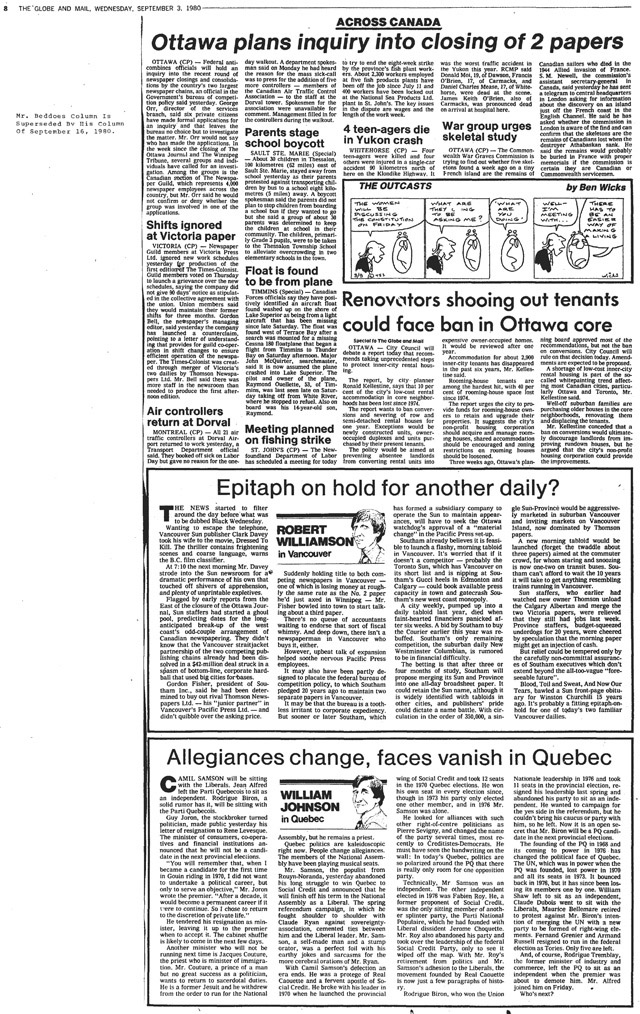
Plagiarism accusations reared their head again a decade later. After a brief suspension for borrowing another writer’s sentence a few months earlier, dance critic Deirdre Kelly was fired in February 1991 after a reader complained that she had plagiarized a description of figure skater Kurt Browning from Maclean’s. According to her 2009 book Paris Times Eight, Kelly took the description from a press kit and placed it into the piece as her deadline loomed.
Kelly fought the firing. While some colleagues had turned against her, she recalled that at least one noted that borrowing text from press kits was standard behaviour and, in a personal letter to her, observed that “if this charge is allowed to stand, then all journalists stand on a gallows trapdoor.”
An arbitrator restored her job in August 1994. Kelly was unhappy with how the paper’s report of her reinstatement made it sound as if a level of plagiarism was acceptable within the industry. The Globe report also quoted a dissenting opinion on the arbitration board, which indicated that “Ms. Kelly’s behaviour, no matter how minor, was wrong” and that she “brought this matter upon herself.” (Kelly remained at the paper until early 2017.)
In September 2012, artist Carol Wainio alleged on her media blog that columnist Margaret Wente had, in a 2009 column titled “Enviro-romanticism is Hurting Africa,” lifted passages from several sources without attribution, most notably a 2008 Ottawa Citizen article by Dan Gardner. Initially, Globe and Mail public editor Sylvia Stead tried to defuse the online outcry in a September 21, 2012, column by indicating that Wente might not have read Gardner’s piece and dismissing the complainant (who had previously documented earlier instances of similar behaviour by Wente) as merely “an anonymous blogger.”
A few days later, the paper revealed that Wente had not met their standards after all. “Even in the spirit of column writing,” stated editor John Stackhouse, “which allows for some latitude in attribution and expression, this work was not in accordance with our code of conduct, and is unacceptable.”
On September 25, Wente defended herself, saying that while she made mistakes, the real problem was she was “a target for people who don’t like what I write.” The same day, Stead published a column listing the lessons learned, and what she and the paper’s staff could do better going forward. There was limited fallout, and a growing sense (according to a newsroom source describing the incident to the Ryerson Review of Journalism) that a “double standard” may have protected a star columnist.
Further allegations against Wente arose in April 2016 from Wainio, BuzzFeed Canada, and Canadaland. Editor-in-chief David Walmsley indicated in the April 25, 2016, edition that staff would continue to work with Wente to ensure it didn’t happen again. There was no apology column from Wente who, as of this writing, is still a columnist for Canada’s National Newspaper.
Additional sources: J.E. Atkinson of the Star by Ross Harkness (Toronto: University of Toronto Press, 1963); Power and Influence by David Hayes (Toronto: Key Porter Books, 1992); King by Allan Levine (Toronto: Douglas & McIntyre, 2011); Bassett by Maggie Siggins (Toronto: James Lorimer & Company, 1979); The Rise and Fall of the Toronto Typographical Union 1832-1972 by Sally F. Zerker (Toronto: University of Toronto Press, 1982); September 1966 edition of the Canadian Historical Review; August 26, 1991, October 7, 1994, and September 24, 2012, editions of The Globe and Mail; January 15, 1949, edition of Maclean’s.
Top image: “Al Nicholson of the Globe and Mail at typewriter with a seal” by Alexandra Studio, circa 1955. City of Toronto Archives, Fonds 1257, Series 1057, Item 3893.
